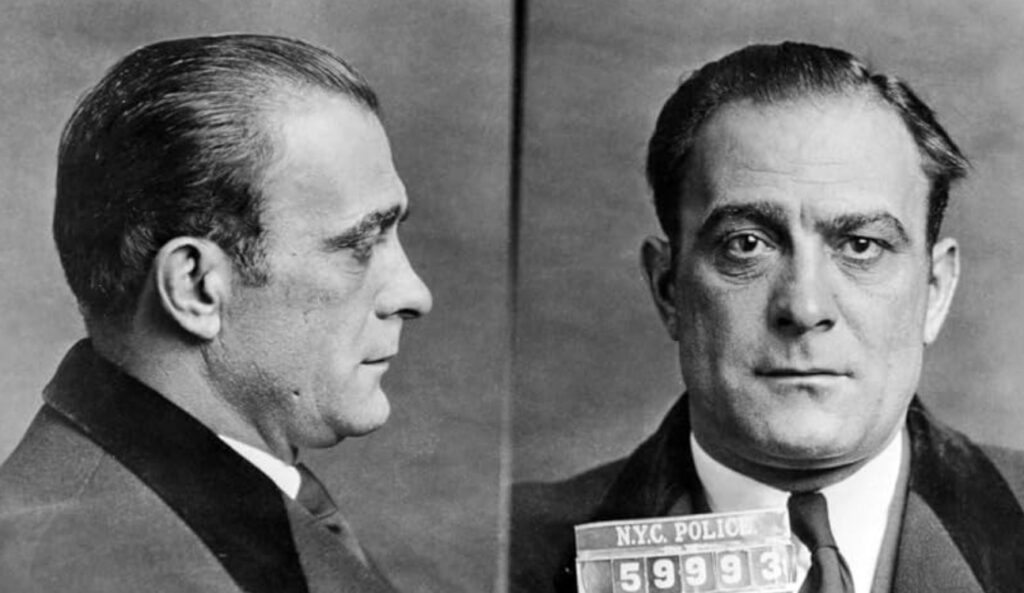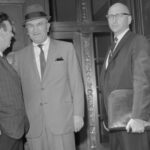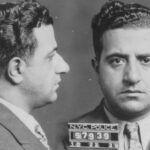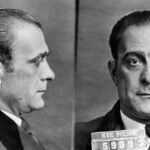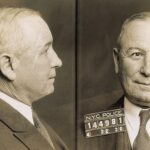Vito Genovese’s story begins in the small Italian town of Risigliano, where he was born on November 21, 1897. His early life in Italy was modest, and in 1913, seeking better opportunities, the Genovese family immigrated to the United States, settling in Manhattan’s Little Italy. This neighborhood, a melting pot of cultures and activities, became the backdrop for young Genovese’s introduction to the world of crime.
The Rise in Organized Crime
Vito Genovese’s entry into the world of organized crime in New York City marked the beginning of a notorious legacy. His initial forays into criminal activities were modest, focusing on small-time thefts. However, as he delved deeper into the criminal underworld, his ambitions and capabilities grew exponentially. The Prohibition era, spanning from 1920 to 1933, was a tumultuous time in American history, characterized by the nationwide constitutional ban on the production, importation, transportation, and sale of alcoholic beverages. This ban created a vast, underground market for illicit alcohol, offering an unprecedented opportunity for organized crime syndicates to flourish.
Genovese, with his keen understanding of the streets and a ruthless approach to business, seized this opportunity. He became deeply involved in the illegal liquor trade, a venture that was both risky and immensely profitable. His ability to navigate this dangerous and competitive arena demonstrated not only his cunning and strategic thinking but also his willingness to use violence as a tool for achieving his goals. This period was crucial in establishing Genovese’s reputation as a formidable and feared figure in the criminal world. His rise was not just a testament to his individual capabilities but also reflective of the broader changes in American society, where prohibition had inadvertently given birth to a new and more organized form of criminal enterprise.
Association with Lucky Luciano and the Castellammarese War
The association between Vito Genovese and Lucky Luciano was more than a mere alliance; it was a partnership that would significantly impact the landscape of organized crime in America. Luciano, already a prominent figure in the Mafia, saw potential in Genovese’s ruthless determination and strategic mind. Their collaboration became one of the most significant in the history of American organized crime.
The Castellammarese War, which raged from 1929 to 1931, was a bloody conflict between two powerful New York Mafia factions. On one side was Joe Masseria, with whom Luciano was initially aligned, and on the other was Salvatore Maranzano. This war was not just a battle for territory or power; it was a struggle for the future direction of the Mafia in America. The old-world ways of the Mustache Petes, traditional Sicilian Mafia bosses like Masseria and Maranzano, were being challenged by the Young Turks, a group of younger, more Americanized mobsters, including Luciano and Genovese.
Genovese’s role in this war was not just as a participant but as a key strategist alongside Luciano. Their actions during this period were marked by a mix of brutal violence and shrewd political maneuvering. The war concluded with Luciano orchestrating the murders of both Masseria and Maranzano, with Genovese playing a crucial role in these plots. This marked the end of the old guard and the rise of a new era in the Mafia, with Luciano and Genovese at the forefront.
The aftermath of the Castellammarese War saw the establishment of The Commission, a governing body for organized crime in America, conceptualized by Luciano and supported by Genovese. This new structure brought an unprecedented level of organization and cooperation between different Mafia families. It was a revolutionary moment in the history of organized crime, and Genovese’s association with Luciano during this period was instrumental in shaping this new direction. Their partnership laid the foundation for what would become the modern American Mafia, an organization that would extend its influence far beyond the streets of New York City.
Leadership and Expansion
In the aftermath of the Castellammarese War, Vito Genovese emerged as a dominant figure in the Mafia’s hierarchy. His ascent to power was not merely a consequence of his survival and participation in the war but also a result of his strategic acumen and relentless ambition. Genovese’s influence extended far beyond the traditional rackets of the Mafia; he ventured into new, more lucrative areas, most notably the narcotics trade. This period saw the Mafia evolve from a predominantly Italian-American bootlegging syndicate into a sophisticated, international criminal organization, and Genovese was at the forefront of this transformation.
His approach to leadership was multifaceted. Genovese was known for his shrewd business sense, which allowed him to identify and capitalize on profitable criminal opportunities. However, his business acumen was matched by a reputation for brutality. He enforced his will through a combination of fear and violence, ensuring loyalty and obedience from his subordinates. This dual approach of calculated business strategies coupled with ruthless enforcement cemented Genovese’s position as a respected and feared leader within the Mafia. His ability to balance these aspects was key to his success and played a significant role in expanding the Mafia’s influence in the criminal underworld.
Exile and Return
The year 1937 marked a significant turning point in Genovese’s life. Facing mounting legal pressures and potential criminal charges in the United States, he made the strategic decision to flee to Italy. This move was not just an escape from legal troubles but also an opportunity for Genovese to expand his criminal network internationally. In Italy, he forged a controversial alliance with Benito Mussolini’s fascist regime. This alliance was indicative of Genovese’s pragmatic approach to power – he was willing to collaborate with anyone who could help him advance his interests, regardless of their political or moral standing.
Genovese’s time in Italy was not just a period of hiding; it was a phase of consolidation and expansion. He engaged in various criminal enterprises, from black market rackets to political maneuvering, further extending his influence and wealth. However, the end of World War II and the fall of Mussolini’s regime meant that Genovese’s safe haven was no longer secure. He made the bold decision to return to the United States to face the charges against him, a move that would start a new chapter in his storied criminal career.
The Genovese Crime Family
Upon his return to the United States, Genovese wasted no time in reasserting his position in the Mafia. He took control of what was formerly known as the Luciano crime family, a move that was both symbolic and strategic. Under his leadership, the family underwent significant changes, both in its operations and its reach. Genovese expanded the family’s involvement in various criminal activities, from traditional rackets like gambling and loan sharking to more sophisticated ventures like labor racketeering and political corruption.
The renaming of the family in his honor was not merely an egoistic gesture; it was a declaration of his unchallenged authority and a testament to his impact on the Mafia. The Genovese crime family, under his leadership, became one of the most powerful and influential Mafia families in the United States. Genovese’s vision for the family was not limited to immediate gains; he laid the groundwork for its future, establishing structures and relationships that would ensure its longevity and dominance in the criminal underworld.
Under Genovese’s leadership, the family became known for its disciplined approach, strategic planning, and the ability to adapt to changing circumstances. This adaptability was crucial in an era where law enforcement was becoming increasingly effective at combating organized crime. Genovese’s foresight in navigating these challenges helped solidify the family’s position and his legacy as one of the most powerful and feared mobsters in American history.
The Apalachin Meeting and Its Aftermath
The Apalachin Meeting in 1957, orchestrated by Vito Genovese, stands as a pivotal moment in the history of organized crime in America. This clandestine summit, held in the small town of Apalachin, New York, was a bold attempt by Genovese to consolidate power and unify the various factions of the Mafia across the country. The meeting was to be a crowning achievement, a demonstration of Genovese’s leadership and vision for the future of organized crime. However, fate had other plans.
The gathering, which brought together numerous high-ranking Mafia figures, was infiltrated by law enforcement. The police raid resulted in many arrests and caused a media sensation. The Apalachin Meeting’s fallout was profound, shattering the Mafia’s veil of secrecy and exposing its vast network to the public and law enforcement agencies. This exposure marked a turning point in the battle against organized crime, leading to increased scrutiny, investigations, and subsequent prosecutions. Genovese’s ambitious plan had backfired spectacularly, dealing a significant blow to the Mafia’s operations and its previously impenetrable facade of invisibility.
Downfall and Legacy
Vito Genovese’s downfall was as dramatic as his rise to power. In 1959, his criminal empire began to crumble when he was convicted on charges of narcotics conspiracy. This conviction was not just a personal defeat for Genovese but also a symbolic blow to the Mafia’s invincibility. Sentenced to prison, Genovese spent the remainder of his life behind bars, passing away in 1969. His incarceration marked the end of an era for the American Mafia, one characterized by his unique blend of strategic brilliance and ruthless tactics.
Despite his downfall, Genovese’s influence on organized crime cannot be overstated. He was instrumental in shaping the modern structure and operations of the Mafia, leaving a legacy that extended far beyond his lifetime. His strategies, methods, and the organizational structures he helped establish continued to influence Mafia operations long after his death. The Genovese crime family, bearing his name, remained a testament to his enduring impact on the criminal underworld.
Wrapping It Up
Vito Genovese’s life story is a complex tapestry of ambition, power, and downfall. His journey from a small town in Italy to the pinnacle of the American Mafia is a stark illustration of the dark corridors of American history in the 20th century. Genovese’s life was marked by his relentless pursuit of power, a pursuit that ultimately led to his undoing. Yet, his legacy endures, not only in the crime family that bears his name but in the very fabric of organized crime in America.
His story serves as a reminder of the intricate and often brutal world of the Mafia, a world where power and peril walk hand in hand. Genovese’s impact on organized crime was profound, and his strategies and methods continue to be studied and emulated by criminal organizations worldwide. In the annals of criminal history, Vito Genovese remains a figure of fascination, a symbol of the Mafia’s golden age, and a testament to the complex interplay of power, crime, and justice in America.

